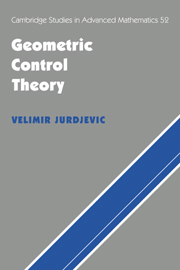Book contents
- Frontmatter
- Contents
- Introduction
- Acknowledgments
- Part one Reachable sets and controllability
- Part two Optimal control theory
- 7 Linear systems with quadratic costs
- 8 The Riccati equation and quadratic systems
- 9 Singular linear quadratic problems
- 10 Time-optimal problems and Fuller's phenomenon
- 11 The maximum principle
- 12 Optimal problems on Lie groups
- 13 Symmetry, integrability, and the Hamilton-Jacobi theory
- 14 Integrable Hamiltonian systems on Lie groups: the elastic problem, its non-Euclidean analogues, and the rolling-sphere problem
- References
- Index
13 - Symmetry, integrability, and the Hamilton-Jacobi theory
Published online by Cambridge University Press: 07 October 2009
- Frontmatter
- Contents
- Introduction
- Acknowledgments
- Part one Reachable sets and controllability
- Part two Optimal control theory
- 7 Linear systems with quadratic costs
- 8 The Riccati equation and quadratic systems
- 9 Singular linear quadratic problems
- 10 Time-optimal problems and Fuller's phenomenon
- 11 The maximum principle
- 12 Optimal problems on Lie groups
- 13 Symmetry, integrability, and the Hamilton-Jacobi theory
- 14 Integrable Hamiltonian systems on Lie groups: the elastic problem, its non-Euclidean analogues, and the rolling-sphere problem
- References
- Index
Summary
Problems of optimal control, like the problems of its classic predecessor, mathematical physics, rely on the integration of Hamiltonian differential equations for their resolution. That remarkable discovery goes back to the work of R. W. Hamilton and C. G. Jacobi concerning the problems of classic mechanics in the 1830s. The content of their publications, subsequently known as the Hamilton-Jacobi theory, had profound impact on subsequent developments in mathematical physics and was the principal source of inspiration for the present theory of Hamiltonian systems. The maximum principle and contemporary optimal control theory are also anchored in the Hamilton-Jacobi theory, and the main issue before us is to understand those classic developments in modern geometric terms and make them accessible for problems of optimal control.
We shall begin this chapter with a related topic: The connection between symmetry and optimality. We shall first arrive at the appropriate definition for “symmetry,” which extends the classic theorem of E. Noether concerning the existence of extra integrals of motion. An extension of that theorem implies, in particular, that a right-invariant vector field is a symmetry for any left-invariant control problem, and consequently the Hamiltonian of the right-invariant vector field is an integral of motion for the extremal system induced by the optimal problem.
The existence of extra integrals of motion for a given Hamiltonian system makes a link with another classic topic: the theory of integrable Hamiltonian systems. That theory, which was discussed extensively by Poincaré (1892) in his treatise on celestial mechanics and later by Carathéodory (1935) in his book on the calculus of variations, is most naturally expressed through the geometry of Lagrangian submanifolds of cotangent bundles.
- Type
- Chapter
- Information
- Geometric Control Theory , pp. 407 - 443Publisher: Cambridge University PressPrint publication year: 1996

